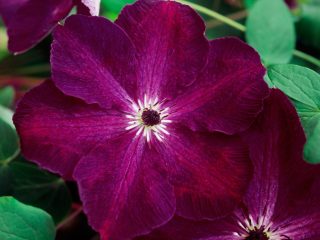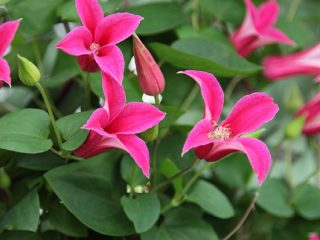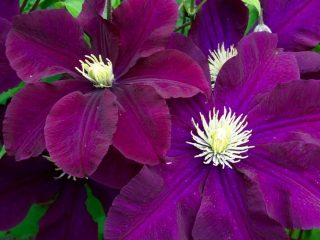Content
Easy to care for and hardy, clematis President or The President is also grown by beginners in floriculture. According to the classification, the large-flowered liana belongs to the Florida group. The variety has been known since the 19th century, named after the head of the British Royal Horticultural Society.
Description
Shrub vine of large-flowered clematis President with a powerful root system that can grow up to 1 m in width and grows up to 2-2.5 m in depth. Thin green shoots climb the support with the help of tenacious tendrils. Leaves up to 10 cm, oval, pointed. Flowers are formed on last year's and new shoots, large, up to 15 cm or more. Peduncles are long. The petals are a rich purple color, with a lighter stripe from the base to a pointed tip, slightly curved upward. The edges of the petals are slightly wavy. The center of the flower is light due to the white base of the burgundy stamens.
Characteristic
Clematis hybrid President is valued for its long, lush flowering in two waves. The first time the buds form on the shoots of the previous year and open at the end of May, beginning of June. New shoots will be adorned with a magnificent cascade of flowers from July to August.The large-flowered plant is very powerful: with the onset of warm nights, the shoots lengthen to 10 cm per day. Over the summer, a young seedling forms up to 5 tall shoots. The liana easily wraps around the trunks of trees and shrubs. Near buildings for large-flowered plants, trellises are installed, which are completely invisible at the time of full development.
The abundantly flowering clematis President serves as a picturesque covering for unsightly objects on the site, turning terraces, balconies or porches into cozy, beautiful corners.
Large-flowered vine requires a large container if it is grown as a potted crop.
Winter-hardy large-flowered clematis President tolerates frost down to -28 OC. The variety is grown in the southern regions, as well as in the middle zone and in more severe climatic conditions with mandatory shelter for the winter.
Reproduction
Hybrid clematis seedlings are obtained in several ways: cuttings, dividing the bush, layering or grafting. It is not always possible to divide a large bush of clematis vine variety President, but sometimes shoots form far from the main mass. They are easy to dig up and take root quickly. Professionals propagate new varieties of hybrid plants using grafting, which is often difficult for beginners to do. Layering is the easiest way to propagate your favorite large-flowered clematis variety President.
- In the direction of growth of a strong shoot, dig a shallow groove and place the vine in it, leaving a 10-15 cm top above the ground;
- The planting must be marked and watered regularly so that new shoots sprout;
- Sprouts of hybrid clematis President are transplanted to a permanent place in the fall or with the onset of next spring.
Cuttings
Propagation of large-flowered plants begins by cuttings before flowering, when small buds are already visible.
- Cut a branch from the middle of a clematis bush and divide it into fragments so that at the top of each segment there are 2 leaves: there should be 2 cm of lash above the leaf, and at least 4 cm below it;
- The leaves are cut in half;
- Before planting, use a growth stimulator in accordance with the instructions;
- For the substrate, take coconut fiber, peat, sand or vermiculite and carefully immerse the cuttings;
- Set up a mini-greenhouse made of glass, plastic, polyethylene, make sure that the substrate is moderately moist;
- Cuttings of a hybrid large-flowered vine take root in 2 weeks or later. The sprouts are transplanted into good soil. President clematis seedlings are transferred to a permanent place after a year.
Growing
A beautiful large-flowered vine is planted in spring and summer, but the best time is September and October.
- For hybrid clematis, choose a sunny place or with light partial shade. The liana does not like strong midday heat; its roots are protected by medium-sized annuals;
- Planting clematis President and care rules provide for placing a large-flowered vine in a place where there is no stagnation of water or drainage of rain flows from the roofs of buildings. Fertile, permeable soils are suitable. The hybrid plant does not develop well on heavy and acidic soils;
- Large flowers and light shoots of large-flowered clematis will suffer from strong winds; for the vine, the best planting is in a sheltered place;
- When placing several vines of vigorous clematis President, one and a half meters are retreated between the holes.
Requirements for a seedling
Shoots from containers take root more easily. But if the root system is open, it should be inspected. Ideally, clematis roots are up to 30 cm long, without thickening or damage. Clematis shoot President with large buds or leaves that have begun to bloom. Before planting, the roots are soaked in water for several hours. Growth stimulants are also used.
Landing
It is better to dig a hole for clematis measuring 0.6 x 0.6 x 0.6 m in advance so that the ground settles. A 10-centimeter layer of drainage is laid at the bottom. The soil is mixed with a bucket of humus and 0.5 liters of wood ash, complex flower fertilizer, following the instructions.
- If clematis President is planted with an open root system, a tubercle is made from the soil and a seedling is placed on it, carefully straightening the roots;
- The root collar and stem are covered with earth so that the lower bud deepens 5-8 cm, then watered;
- When planting in spring, the large-flowered vine is deepened to the first internode.
In the spring, part of the soil from above is also removed from the hybrid clematis planted in autumn, making a depression to make it easier for new shoots to sprout from the still weak root.
Care
As soon as the shoots begin to grow, they must be carefully tied to a support, pointing in the right direction. Some of the shoots of the large-flowered vine are directed horizontally so that the flowering covers the entire decorative lattice. The abundantly flowering clematis President requires systematic care in order to please the gardener with good development. The hybrid vine is provided with weekly watering, and in hot weather - 2-3 times a week. The first year, 10-20 liters of water are poured out at a time; the grown large-flowered plant is given double the volume - up to 40 liters.After watering, the soil is loosened; on hot days, a layer of mulch is laid from weed and herbs.
In spring, hybrid clematis is treated with fungicides for prevention. In the summer, when aphids and spider mites appear, insecticides and acaricides are used.
Top dressing
If possible, clematis President is given organic fertilizer. In the winter, humus is poured onto the hole; in the summer, liquid solutions of mullein or bird droppings are added 3-4 times. The large-flowered plant is fertilized with minerals 3 times:
- As the vines begin to develop, dissolve 30-40 g of urea in 10 liters of water. Consumption – 5 liters per bush;
- In the flowering phase, clematis President is fertilized with a solution of 30-40 g of nitrophoska and 20 g of potassium humate per 10 liters. Consumption – a bucket per bush;
- After flowering, the vine is maintained with a solution of 40 g of superphosphate and potassium sulfate in 10 liters of water. Consumption - half a bucket per hole. Superphosphate is soaked in a liter of hot water overnight and then diluted to normal.
The retail chain has many different offers of flower fertilizers, which you can also use. Organomineral fertilizers “Ideal” and other preparations of this type are beneficial for the hybrid vine President.
Trimming
To regulate the flowering process, shoots are pruned twice in large-flowered clematis, pruning group 2. Clematis President also belongs to this category. After allowing the first wave to bloom, all shoots from last year are cut off at the base. In September, shoots that have grown since spring are pruned. There are two options for this trimming. If the entire shoot is cut back to the root, there will be no early flowering next spring. In order for clematis to bloom in June, only the generative part where there were flowers is cut off on the current year's shoots.
Preparing for winter
The winter hardiness of clematis President is high, but in the conditions of central Russia the plant is covered. In autumn, peat, fallen leaves, and sawdust are placed in the projection of the hole. The vine is removed from the support and carefully rolled up. With the onset of frost, spruce branches or dry remains of garden and flower plants are placed. Open gradually in warm weather.
A spectacular large-flowered vine will respond to careful care with beautiful flowering. By feeding and protecting the plant from frost, the gardener will admire the purple stars for years.
















